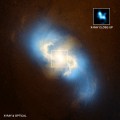Five billion years from now, our Milky Way galaxy will collide with the Andromeda galaxy. This will mark a moment of both destruction and creation. The galaxies will lose their separate identities as they merge into one. At the same time, cosmic clouds of gas and dust will smash together, triggering the birth of new stars.

This three-color image of NGC 935 and its companion IC 1801 shows far-UV emission from young stars observed by GALEX in blue, heated dust mid-infrared emission observed by Spitzer in red, and stellar near-infrared emission observed by Spitzer in green. This pair of spiral galaxies is beginning to crash into each other. (Image credit: NASA / JPL-Caltech / Harvard-Smithsonian CfA)
To understand our past and imagine our future, we must understand what happens when galaxies collide. But since galaxy collisions take place over millions to billions of years, we can’t watch a single collision from start to finish. Instead, we must study a variety of colliding galaxies at different stages. By combining recent data from two space telescopes, astronomers are gaining fresh insights into the collision process.
“We’ve assembled an atlas of galactic ‘train wrecks’ from start to finish. This atlas is the first step in reading the story of how galaxies form, grow, and evolve,” said lead author Lauranne Lanz of the Harvard-Smithsonian Center for Astrophysics (CfA).
Lanz presented her findings today in a press conference at the 218th meeting of the American Astronomical Society.
The new images combine observations from NASA’s Spitzer Space Telescope, which observes infrared light, and NASA’s Galaxy Evolution Explorer (GALEX) spacecraft, which observes ultraviolet light. By analyzing information from different parts of the light spectrum, scientists can learn much more than from a single wavelength alone, because different components of a galaxy are highlighted.

Three-color image of NGC 470 (top) and NGC 474 (bottom) showing far-UV emission from young stars observed by GALEX in blue, heated dust mid-infrared emission observed by Spitzer in red, and stellar near-infrared emission observed by Spitzer in green. These galaxies are likely to be on their first pass past each other and are therefore relatively undisturbed at a separation of 160,000 light-years. (Image Credit: NASA / JPL-Caltech / Harvard-Smithsonian CfA)
GALEX’s ultraviolet data captures the emission from hot young stars. Spitzer sees the infrared emission from warm dust heated by those stars, as well as from stellar surfaces. Therefore, GALEX’s ultraviolet data and Spitzer’s infrared data highlight areas where stars are forming most rapidly, and together permit a more complete census of the new stars.
Lanz’s co-authors are Nicola Brassington (Univ. of Hertfordshire, UK); Andreas Zezas (Univ. of Crete, Greece, and CfA); Howard Smith and Matt Ashby (CfA); Christopher Klein (UC Berkeley); and Patrik Jonsson, Lars Hernquist, and Giovanni Fazio (CfA).





